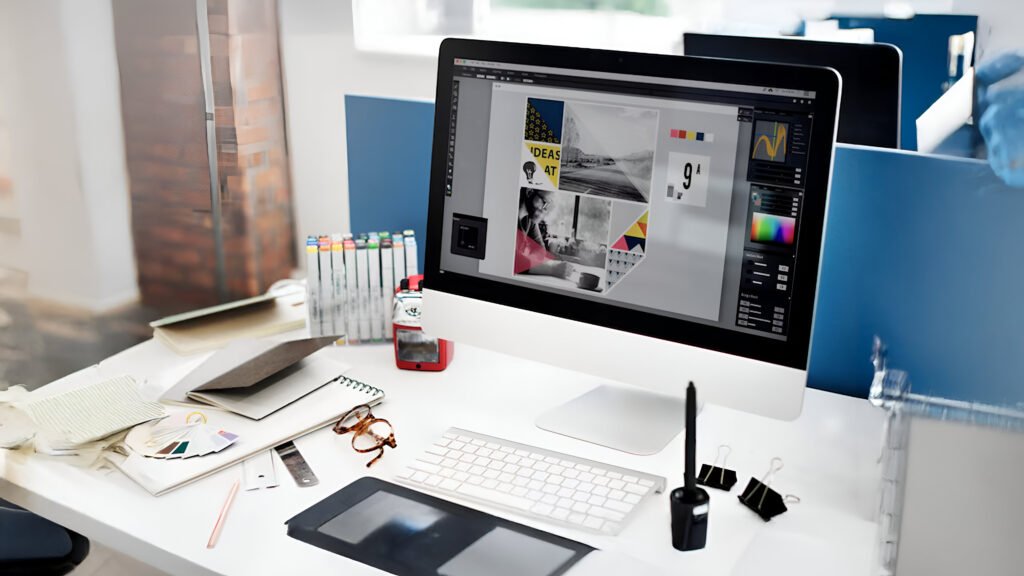In today’s visually driven world, businesses across industries are realizing the critical role that graphic design plays in shaping their success. Whether you’re a small startup or a large corporation, effective graphic design can serve as a powerful tool to improve your brand’s identity, communication, and customer engagement. This blog explores why graphic design is essential for any business and how it can directly impact your company’s growth and success.
The Role of Graphic Design in Business
Graphic design is all about using visuals to communicate ideas clearly and effectively. In a business context, graphic design covers a variety of elements such as logos, marketing materials, websites, packaging, and advertisements. It helps businesses convey their identity, values, and services in a way that resonates with their target audience.
Good graphic design helps a brand stand out, build trust, and connect better with its audience. Whether you’re operating in the digital space or through traditional media, the right design can improve your business in the eyes of your consumers and establish lasting connections.
Creating a Memorable Brand Identity
One of the most immediate benefits of graphic design for business is the creation of a strong, recognizable brand identity. A company’s logo, colour palette, typography, and visual style all come together to create a unique image that helps customers identify and remember the brand. In fact, a study by The Design Council revealed that businesses with strong, consistent branding can increase their revenue by 23%.
Consider some of the world’s most successful brands like Coca-Cola, Apple, or Nike. Each of these companies has carefully created their graphic design to reflect their values and connect with their customers on a deeper level. When executed well, these designs not only capture attention but also improve emotional responses, building trust and loyalty over time.
Improves Communication and Marketing
Effective communication is a key aspect of any business strategy, and graphic design plays a vital role in this. Whether you’re creating brochures, flyers, website content, or social media posts, visual elements can enhance the clarity and effectiveness of your message.
Infographics are a great design tool for explaining complex ideas or products in a clear and engaging way. According to research by NeoPhotonics, content that includes relevant images receives 94% more views compared to content without images. Infographics break down complicated data into easily understandable visuals, making it simpler for customers to understand your offerings.
Building Professionalism and Credibility
Graphic design is essential for making a business appear professional and trustworthy. An outdated or poorly designed logo or website can give the impression of being unreliable or disorganized. On the other hand, high-quality design demonstrates that a business is serious about its branding and cares about the user experience.
When a business invests in professional graphic design, it signals to its audience that it prioritizes quality and precision. This is particularly important in industries like corporate services, where trust and professionalism are critical to client relationships.
Corporate businesses, for example, often use graphic design in their annual reports, presentations, and internal communications. These materials must communicate key information clearly and effectively while maintaining a polished, cohesive look. A consistent and carefully planned design ensures that all company communications reflect its values and brand identity.
The Competitive Advantage of Graphic Design for Corporate Businesses
In the corporate world, where competition is strong and first impressions matter, high-quality graphic design can provide a significant advantage. For large corporations, the visual aspects of branding and marketing can influence everything from investor perceptions to consumer behaviour.
A case study from Coca-Cola’s rebranding initiative in the 1960s is a perfect example of how design can change a company’s market position. When Coca-Cola decided to update its logo and packaging, it achieved a more modern, visually appealing design that resonated with its customers. The result was a remarkable boost in sales and consumer engagement, proving the immense value of design in the corporate space.
Additionally, in B2B (business-to-business) marketing, corporations often use graphic design for digital and print collateral. This includes white papers, case studies, and product catalogs, all of which need to communicate complex information clearly while maintaining a professional appearance. Graphic design for business in the corporate sector involves creating materials that reflect the company’s stature, expertise, and reliability, which is essential for attracting and retaining clients.
Graphic Design’s Impact on Customer Perception
The visual elements associated with a brand contribute significantly to how customers perceive it. A recent survey by Lucidpress found that 60% of consumers will not buy from a brand whose logo or overall design they find unattractive. In contrast, businesses that focus on creating an appealing visual identity are more likely to create a positive first impression and encourage consumer trust.
Furthermore, graphic design can influence the user experience (UX) on digital platforms. A well-designed website, for example, is not only visually appealing but also user-friendly, making it easier for visitors to navigate and find information. This directly impacts how customers interact with your brand and, ultimately, their decision to make a purchase or engage further with your services.
Supporting Your Business with Data and Research
The importance of graphic design is not just anecdotal—numerous studies support its impact on business success. For example, a study conducted by The Creative Group found that 75% of consumers form judgments about a company’s credibility based on the design of its website. This shows how deeply design influences perception and decision-making processes.
Additionally, an analysis by McKinsey & Company found that companies with a strong design presence outperform their competitors by 32% in terms of revenue growth. This research reinforces the idea that investing in professional graphic design is not just a creative choice, but a strategic business decision that can pay off in the long run.
Conclusion: Investing in Graphic Design is Essential for Success
In today’s business landscape, graphic design is more than just an aesthetic choice; it’s an essential part of building a strong brand, improving communication, and maintaining a professional image. From corporate marketing materials to user interfaces and branding, design influences every interaction a customer has with your business.
For businesses of all sizes and industries, investing in high-quality graphic design can lead to increased customer engagement, improved brand recognition, and a significant competitive advantage. Whether you are a startup looking to make your mark or a large corporation striving to stay ahead, graphic design is the cornerstone of your business strategy.
By prioritizing graphic design, you are not only improving the visual appeal of your brand but also setting the foundation for long-term growth and success.


